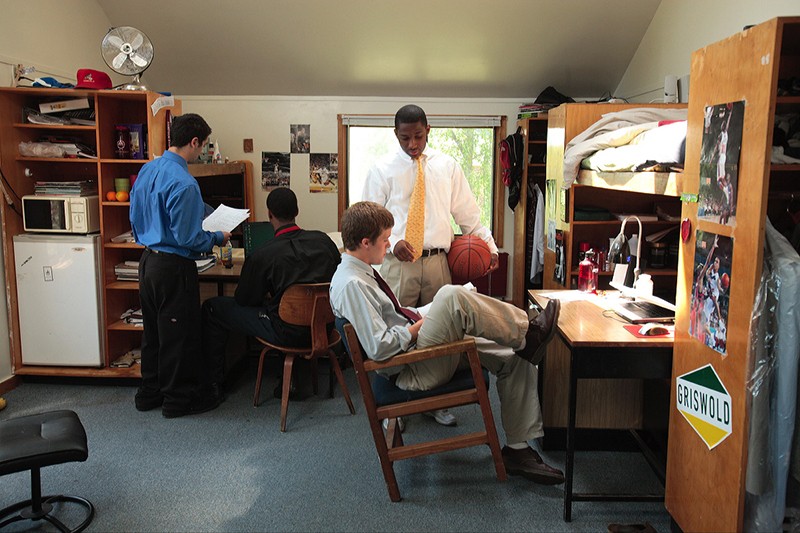- About
- Admissions
- Academics
- Athletics
- Student Life
« Back
Nine Things Your Dorm Does Not Need
August 1st, 2022

At the end of each year, once all the students have left, the dorm faculty and staff walk through the residential houses to check the condition of the rooms and deal with the remnants left behind. It is during these walks, over the years, that we have noticed a pattern of the most common items that have gone unused. Using this information, we have composed the following list of the top nine things your son should not bring with him to South Kent School:
- Furniture & Mattresses: All residence house rooms are filled with the necessary items for every student: a bed, a desk, a chair, a closet or armoire, a dresser, and a safe. Additional furniture is not permitted in the rooms per the state fire code. Outside mattresses are also not allowed for fire safety concerns. If comfort is the goal, you are welcome to bring a mattress topper, but not a replacement mattress.
- Cases of Water: Every year, students order cases of water to be delivered to the school. Hydrating is essential, but single-use plastic bottles are detrimental to the environment and costly. For this reason, we encourage students to have a reusable water bottle (or two) that they can fill up on campus. If they prefer something with more flavor, we recommend flavored powder packs to add to their water bottles instead of purchasing cases of Gatorade or other similar drinks.
- Appliances: Students are always curious whether they can bring small appliances to keep in their rooms, such as coffee machines, tea kettles, rice cookers, hot pots, and toasters. Appliances, particularly those with heating elements, are not permitted in a student’s room per the state fire code. If such items are found in rooms, they will be confiscated, and the student will be responsible for returning the item to their home.
- Big Screen TVs: While TVs and monitors are allowed for students, the Handbook states that these devices cannot exceed 25”. Monitors or TVs that exceed this size offer an easy distraction. Believe us when we say it, the whole residence house is not gathered in one student’s room to watch Bill Nye’s newest video about osmosis on a 65” high-definition TV in his room. Larger TVs are available in the common areas of all dormitories.
- OTC Medications: Each year, students arrive at school with a mix of OTC medications. Instead of having these medications in the dorms, we encourage families to direct their students to the Health Center if they are not feeling well or would like some medicines to assist with any symptoms. The Health Center can provide the treatment needed for students who are not feeling well, including the appropriate medication to help them manage their symptoms.
- School Supplies: Believe it or not, the most common things that are left behind unused are school supplies, including notebooks, loose leaf paper, boxes of pencils, pens, packs of highlighters and sticky notes, and everything in between. We suggest purchasing a minimum amount of school supplies: a notebook or two, some pens and pencils. Once the year begins, your student can determine what else he needs and purchase it then. Many school assignments are digitized these days, so your student will likely not need as many school supplies as you think.
- Air Fresheners: While air fresheners smell great and can help brighten any teenage boy’s room, they ultimately go unused. At the end of the year, we find many air fresheners unopened and left in rooms. Additionally, the plug-in version of these air fresheners can pose a fire safety concern if left plugged in and empty. Some good old-fashioned deodorant, frequent laundering of clothes, and good hygiene are best for keeping the boys, and their rooms, smelling good!
- Storage Containers: Year after year, there is a Rubbermaid graveyard in the residence houses. Large storage containers (i.e., big drawer sets, storage totes, etc.) are left behind, and while some may get repurposed, many go straight to the dumpster. While these organizers can be helpful, they take up valuable space in the students’ rooms. For this reason, we recommend purchasing small shelf and drawer organizers for the furniture provided by the school. Each room has a dresser and an armoire, so there is ample space for storage, though students can use these smaller shelf organizers and containers to stay neat and organized.
- Luggage: Students travel to South Kent from all over the world, and with them, they will bring luggage. While the residence houses offer some spaces for students to store suitcases during the year, space is limited. Some students elect to keep their suitcases in their rooms, which uses valuable space. We recommend that students travel with collapsible duffle bags when possible (or even the infamous Ikea blue tarp bags). These travel items are storage-friendly and take up less space when not being used
As every student prepares to move onto campus, they want to make their rooms feel as much like home as possible. While we support the students in making the spaces their own, we also encourage them to follow one of the school’s founding values, Simplicity of Life.
With the ease of online shopping, students can buy things that they need when they need them. Getting rid of something they don’t have space for is much more challenging. Overall, the best advice we can offer is Less Is More. By keeping a clean, well-organized, and uncluttered living space, students can focus on what brought them to the Hillside and live by another school’s founding value, Directness of Purpose












